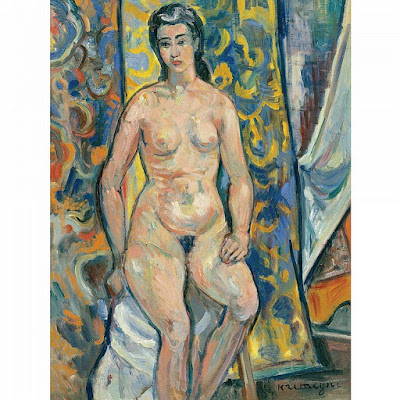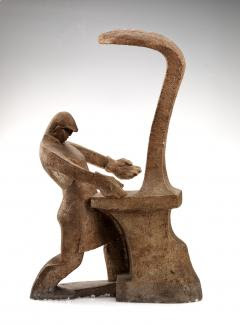 |
| Seattle, WA. Former Bikur Cholim Synagogue, 17th Avenue and Yesler Way, 1912-1915, B. Marcus Pritica, architect. Now Langston Hughes Cultural Arts Center. Photo: Samuel Gruber 2019. |
 |
| Seattle, WA. Former Herzl Congregation, 20th Avenue and East Spruce Street, 1925. Now Seattle Classical Christian School. Photo: Samuel Gruber 2019. |
 |
| Seattle, WA. Former Sephardic Bikur Holim, 20th Avenue and East Fir Street, 1924. Now Tolliver Temple (church). Photo: Samuel Gruber 2019. |
by Samuel D. Gruber
On a recent visit to Seattle I walked in the neighborhood between Yesler Way and Cherry Street, once the heart of the city's Jewish neighborhood. Like many American cities of the early 20th century the Jewish population was not big enough to define an entire neighborhood, but Jews were part of a vibrant ethnic and racial mix of "Jews, Scandinavians, African Americans and Asians. no one census tract in the area ever had more than 41 percent of Jewish residents." (Family of Strangers, 138-139). This type of population mi, coming on the heels of World War I, was essential to the Americanization process of Jewish immigrants - and many other groups - though African Americans and Asians were provided substantially fewer opportunities due to systemic racism.
Historian Deborah Dash Moore has written "Jews were too small a part of most cities' populations to do more than set the tone through the establishment of organizations and businesses and by the presence of religious and cultural activities...Jews could dominate blocks but never whole neighborhoods." (Moore, "The Construction of Community," 107) This was also the case in my own city of Syracuse, New York, where the "Jewish" 15th Ward was really during the interwar period a richly diverse community of other European immigrant groups and some African Americans.
At least three former synagogue buildings, including one more than a century old and an early work of B. Marcus Pritica, one of America's leading Jewish architects, still stand and all have been effectively repurposed. None of the buildings or associated signage announce their Jewish history, but all still bear visible traces of their earlier Jewish identity.
Former Bikur Cholim (1915)
Bikur Cholim Synagogue at 17th Street and Yesler Way was for decades the anchor of the Jewish Community. it was designed by Scottish-born Jewish architect B. Marcus Pritica (1889 – 1971) who was brought in mid-construction to re-design a failed project. Pritica studied architecture and began his profession in Glasgow, but came to Seattle as a young man, where he soon met theater impresario Alexander Pantages under whose patronage he would become one of America's most esteemed and prolific theater architects.
 |
| Seattle, WA. Bikur Cholim Synagogue, 17th Avenue and Yesler Way, 1912-1915, B. Marcus Pritica, architect. Now Langston Hughes Cultural Arts Center. Photo: Samuel Gruber 2019. |
 |
| Seattle, WA. Former Bikur Cholim, 17th Avenue and Yesler Way, 1912-1915, B. Marcus Pritica, architect. A Jewish Star was formerly in the roundel. Photo: Samuel Gruber 2019. |
 |
| Seattle, WA. Former Bikur Cholim, 17th Avenue and Yesler Way, 1912-1915, B. Marcus Pritica, architect. Rich and varied tile decoration. Photo: Samuel Gruber 2019. |
 |
| Seattle, WA. Former Bikur Cholim, 17th Avenue and Yesler Way, 1912-1915, B. Marcus Pritica, architect. Rich and varied tile decoration. Photo: Samuel Gruber 2019. |
The compact domed structure, with Romanesque, Classical, and contemporary - almost jazzy - decoration picks up on Central European synagogue design trends of the early 20th-century when center-dome buildings like that of Sofia, Bulgaria, became more common. Because of publications, the gap between Europe and America was narrow. Touro Synagogue was completed in 1909. The synagogue in Trencin, Slovakia is from 1913, and Seattle's Bikur Cholim was completed in 1915. After the Colombian Exposition of 1893 in Chicago, domed structures were all the rage in America for a wide range of building types and formed a major component of "American Renaissance" design. Weil's and Pritica's synagogues offered a new model that was not based on classical prototypes, and architecturally expressed power and weight more than soaring idealism.
 |
| Pittsburgh, PA. Temple Rodef Sholom. Henry Hornbostel, architect, 1904. Photo:Paul Rocheleau, 2002. |
 |
| New Orleans, Louisiana. Touro Synaoggue. Eugene Weil. architect, 1907-1909. Postcard. |
In 1906, Congregation Herzl was founded as an Orthodox and Zionist synagogue, by a group of members from Chevra Bikur Cholim. They began to build a synagogue at Sixteenth Avenue and East Fir street in 1909, but it appears they never fully complete the building due to financial and other problems. They gave it another go in 1923 under the leadership of their new rabbi, Baruch Shapiro, and in 1925 they moved into their completed synagogue at Twentieth Avenue and East Spruce Street. This survives today as the Seattle Classical Christian School. Today, the exterior is only slightly changed, but the interior has been almost entirely remodeled. Still, one can understand the original arrangement, which was a common one for Orthodox urban synagogue built in the 1920s.
The monumental approach was up steps from the street and through three main doors. The site slopes to the east, and this allows most of the basement level - which would have had classrooms and social space - to enjoy large above ground windows. Overall, the design of the building is quite compact. There were not corner towers, but insides, stairways on either side led to the women’s galleries which wrapped around three sides of the sanctuary. This articulation is still clearly visible from the outside, and inside the big arched windows of the women’s gallery light classrooms and offices. The sanctuary itself has been divided into two full stories, with a floor run across the space linking the side balcony levels.
In 1929, Congregation Herzl become a Conservative synagogue. The congregation dwindled in the post-war years as the neighborhood changed, and the building was sold in 1969. Congregation Herzl and Congregation Ner Tamid merged in 1970 to form Herzl-Ner Tamid Conservative Congregation. In 1968, land on Mercer Island was purchased. A new building at 3700 E Mercer Way designed by architect James Chiarelli was dedicated in 1971.
 |
| Seattle, WA. Former Herzl Congregation, 20th Avenue and East Spruce Street, 1925. Now Seattle Classical Christian School. Photo: Samuel Gruber 2019. |
 |
| Seattle, WA. Former Herzl Congregation, 20th Avenue and East Spruce Street, 1925. This is a new floor across the sanctuary space. Photo: Samuel Gruber 2019 |
A third surviving synagogue in the area is the former Sephardic Bikur Cholim, built in a modest Romanesque style and completed in 1928, at the SW corner of Twentieth Avenue and East Fir Street. The congregation was founded in 1916 by Sephardi Jews from Rhodes, but it was not until they recruited Haham Abraham Maimon from Tekirday in Turkey, that they grew in size and organization, and were able to built a purpose-built home. The entire Jewish community - Sephardi and Ashkenazi - came together to raise the money for the new synagogue which was completed in 1929. No doubt, if the congregation waited another year or two, this would have been impossible. Haham Maimon died in 1931, but he was soon succeeded by his son the multi-lingual and multi-talented Solomon Maimon, who led the congregation for decades.
The synagogue was sold in the early 1960s when the congregation decided to moved south to Seward Park, where a new building was designed and erected by B. Marcus Pritica - still active in Seattle, and engaged with the Jewish community. The former synagogue is now a church - the Tolliver Temple.Though the east facade faces Twentieth Street, the entrance is from East Fir so that the Ark wall is left free. The exterior suggests that after entering one would turn left to enter the sanctuary. Most likely the two-story articulation to the right of the entrance at the western end of the building was for office and classroom space.
There is still some decoration from the synagogue on the exterior, where a Decalogue without inscription remains above the main door, and Jewish stars are intact on the wooden entrance doors and above some windows. Photos from the recent past supplied by Julian Preisler show that not long ago the Tablets were legible and there also an inscription over the door, but these have now been covered over. This is a very much a transitional building. The decoration is historicist, but the size, massing, and plan could easily belong to a modest starkly modern brick synagogue of the box-type that would become common in the 1940s and 1950s.
 |
| Seattle, WA. Former Sephardic Bikur Holim, 20th Avenue and East Fir Street, 1924. Now Tolliver Temple (church). Photo: Samuel Gruber 2019. |
 |
| Seattle, WA. Former Sephardic Bikur Holim, 20th Avenue and East Fir Street, 1924. Now Tolliver Temple (church). Photo: Samuel Gruber 2019. |
 |
| Seattle, WA. Former Sephardic Bikur Holim, 20th Avenue and East Fir Street, 1924. Now Tolliver Temple (church). Photo courtesy of Julian Preisler, n.d. |
 |
| Seattle, WA. Former Sephardic Bikur Holim, 20th Avenue and East Fir Street, 1924. Now Tolliver Temple (church). Photo: Samuel Gruber 2019. |
 |
| Seattle, WA. Former Sephardic Bikur Holim, 20th Avenue and East Fir Street, 1924. Now Tolliver Temple (church). Photo: Samuel Gruber 2019. |
 |
| Seattle, WA. Former Sephardic Bikur Holim, 20th Avenue and East Fir Street, 1924. Now Tolliver Temple (church). Photo: Samuel Gruber 2019. |
 |
| Seattle, WA. Former Sephardic Bikur Holim, 20th Avenue and East Fir Street, 1924. Now Tolliver Temple (church). Photo: Samuel Gruber 2019. |
Buttnick, Meta. “Congregation Bikur Holim-Machzikay Hadath of Seattle: The Beginning Years,” Western States Jewish History 22/2
Buttnick, Meta. “Herzl-Ner Tamid Conservative Congregation of Seattle: The Beginning Years, Part 1,” Western States Jewish History 25/3.
Buttnick, Meta. “Herzl-Ner Tamid Conservative Congregation of Seattle: The Beginning Years, Part 2,” Western States Jewish History 25/4.
Cone, Molly, Droker, Howard, and Williams, Jacqueline, Family of Strangers: Building a Jewish Community in Washington State (Seattle: Washington State Jewish Historical Society and University of Washington Press, 2003).
Moore, Deborah Dash, "The Construction of Community; Jewish Migration and Ethnicity in the United States," in The Jews of North America, ed. Moses Rischin, (Detroit: Wayne State University Press, 1987).
Normand, Eugene, 2013. "A Tale of Two Cities' Jewish Architects: Emile Weil of New Orleans and B. Marcus Priteca of Seattle," Southern Jewish History 16 (2013), pp. 1-41.
Sutermeister, Miriam, 1994. "B. Marcus Pritica," in Shaping Seattle Architecture: A Historical Guide to the Architects, ed. J.K. Ochsner. Univ. of Washington Press, Seattle, 180-185.
Tarrach, Dean A. . Alexander Pantages: The Seattle Pantages and his Vaudeville Circuit, (Seattle: University of Washington, 1972.




































